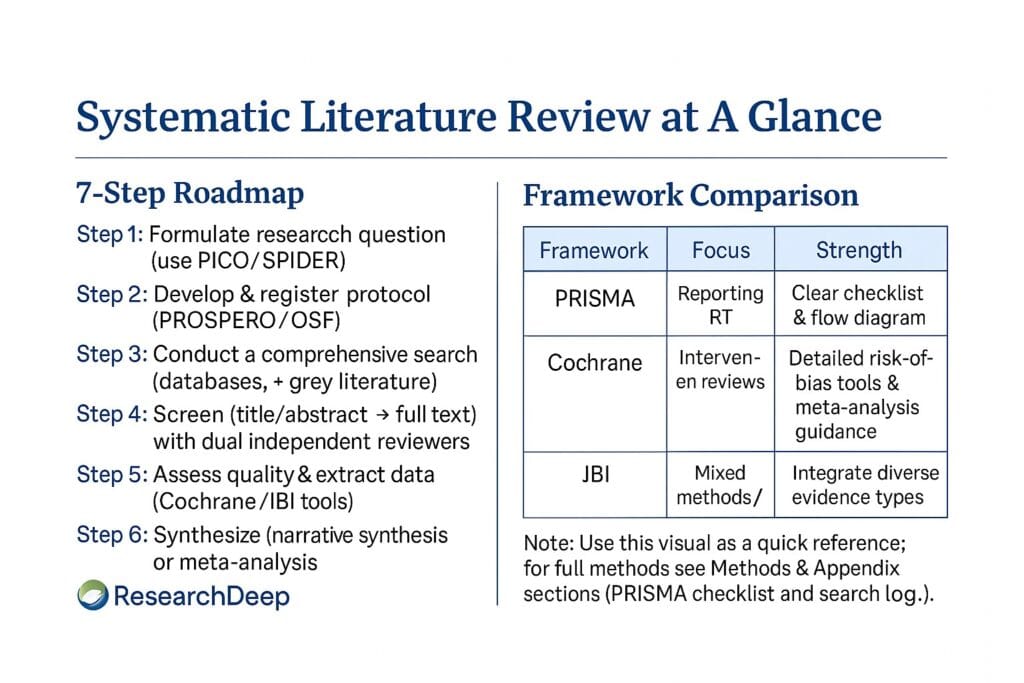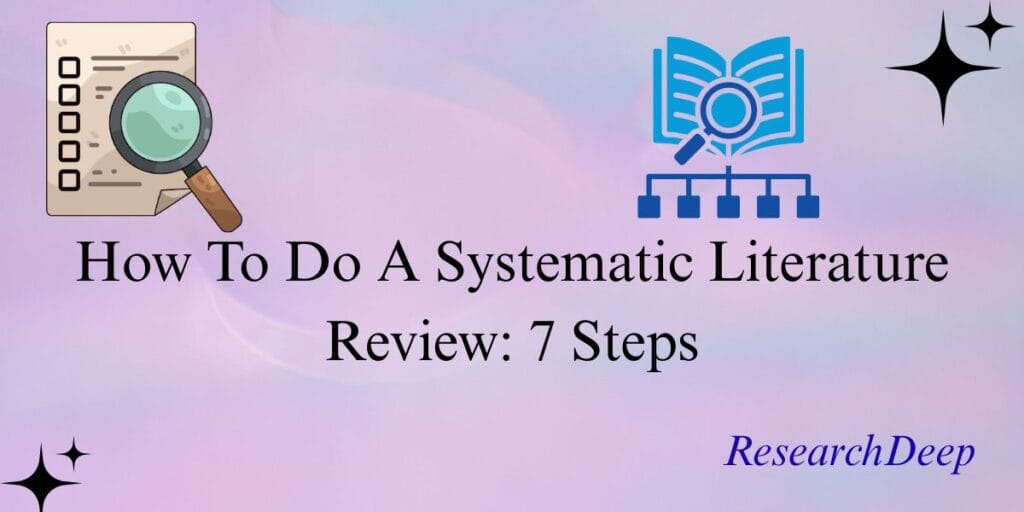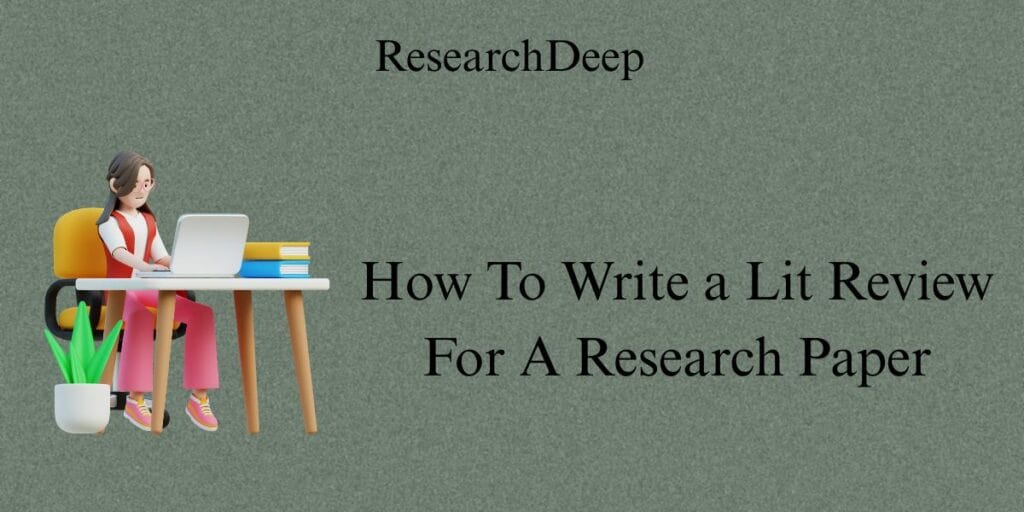Introduction
Understanding how to do a systematic literature review is essential for researchers seeking to produce credible, transparent, and reproducible syntheses of existing evidence.
A systematic literature review (SLR) is a rigorous method that identifies, evaluates, and synthesizes all available research related to a specific research question, following a clearly defined and replicable process (Page et al., 2021; Higgins et al., 2022).
Unlike a traditional literature review or a narrative review, which may be selective or interpretive, a systematic review employs structured protocols designed to minimize bias and enhance the reliability of findings.
It is widely used in fields such as medicine, psychology, social sciences, and public policy, where evidence-based conclusions are critical for advancing knowledge and informing decision-making.
By adhering to frameworks such as PRISMA, Cochrane, and JBI, scholars can ensure their reviews meet the highest standards of transparency, rigor, and reproducibility.
Table of Contents
Step 1: Formulate the Research Question
Every systematic literature review begins with a well-defined, good research question. A straightforward research question shapes your search strategy, inclusion criteria, and analysis.
A standard tool used in this context is the PICO framework (Population, Intervention, Comparison, and Outcome), particularly in the health and social sciences (Richardson et al., 1995).
Example:
- Population/Problem: Adults with type 2 diabetes
- Intervention: Dietary interventions
- Comparison: Standard medical care
- Outcome: Improved glycemic control
Beyond PICO, frameworks such as SPIDER (Sample, Phenomenon of Interest, Design, Evaluation, Research type) are used in qualitative research.
Tip: Form a multidisciplinary team. Involving multiple reviewers from diverse backgrounds enhances objectivity and minimizes selection bias (Liberati et al., 2009).
Step 2: Develop a Protocol
A protocol is the blueprint for your systematic review — it defines your objectives, inclusion/exclusion criteria, search strategy, and data extraction methods. Writing it beforehand ensures rigor and transparency (Higgins et al., 2022).
Key Actions:
- Register your protocol: Utilize registries such as PROSPERO or the Open Science Framework (OSF).
- Include details such as:
- Research objectives
- Study eligibility criteria
- Databases and search terms
- Data extraction plan
- Statistical or thematic synthesis method
Why this matters: Registration prevents duplication and allows the research community to validate your methodology (Moher et al., 2015).
Step 3: Conduct the Literature Search
The literature search is at the heart of your SLR. It ensures comprehensive coverage of all relevant studies and minimizes publication bias.
Steps to follow:
- Databases: Search multiple academic databases and search engines— PubMed, Scopus, Web of Science, PsycINFO, ERIC, or IEEE Xplore, depending on your field.
- Search Strategy: Use Boolean operators (AND, OR, NOT), truncations, and synonyms. For example: (“climate change” OR “global warming”) AND (“policy” OR “regulation”)
- Grey Literature: Include unpublished reports, conference papers, and theses to prevent bias toward positive findings (Adams et al., 2017).
- Manual Search: Review reference lists of key studies for missed citations.
Please keep a record of your search terms, databases, and the dates you used them. This transparency allows replication and supports reproducibility.

Step 4: Screen the Literature
After gathering your sources, you must systematically screen and filter studies to determine eligibility.
Two-phase process:
- Title and Abstract Screening: Quickly Eliminate Irrelevant Results.
- Full-text Review: Carefully assess remaining studies against inclusion/exclusion criteria.
Use tools such as Rayyan, Covidence, or DistillerSR for efficient dual screening. Maintain a PRISMA flow diagram to record inclusions, exclusions, and reasons for exclusion (Page et al., 2021).
Tip: Two independent reviewers should screen all studies to minimize bias.
Step 5: Assess the Quality and Extract Data
Assessing methodological quality ensures that only reliable evidence informs your synthesis.
Quality Assessment Tools:
- Cochrane Risk of Bias Tool (for RCTs)
- CASP checklists (for qualitative studies)
- JBI Critical Appraisal Tools (for mixed methods)
Create a standardized data extraction sheet (e.g., Excel or Covidence) to record:
- Study design
- Sample size and characteristics
- Interventions and outcomes
- Key results and limitations
Perform data extraction independently by at least two reviewers for consistency (Higgins et al., 2022).
Step 6: Synthesize the Findings
Qualitative Synthesis:
Used when data are heterogeneous. Identify themes, research gaps, and contradictions across studies through thematic or narrative synthesis.
Quantitative Synthesis (Meta-analysis):
When data are homogeneous, use statistical methods to combine effect sizes and compute pooled estimates. Software like RevMan, R (meta package), or Comprehensive Meta-Analysis can be employed.
Highlight inconsistencies and perform sensitivity analyses to evaluate robustness.
Step 7: Interpret and Present the Results
Your final step is to report, interpret, and discuss findings transparently.
Structure your report:
- Abstract: Concise overview of objectives, methods, and key findings
- Introduction: Rationale and background
- Methods: Detailed description of search and screening
- Results: PRISMA flowchart, tables, and summary
- Discussion: Interpretation, implications, limitations
- Conclusion: Future research directions
Follow the PRISMA 2020 reporting checklist (Page et al., 2021). Mention any biases, publication gaps, and methodological weaknesses.
Comparative Table: Framework Differences
| Framework | Primary Domain | Key Document | Key Strength | DOI Reference |
|---|---|---|---|---|
| PRISMA (2020) | Multidisciplinary | Page et al. (2021) | Transparent reporting | 10.1136/bmj.n71 |
| Cochrane Handbook | Health Sciences | Higgins et al. (2022) | Rigorous risk of bias tools | 10.1002/9781119536604 |
| JBI Manual | Mixed/Qualitative | Aromataris & Munn (2020) | Integration of diverse designs | 10.46658/JBIMES-20-01 |
FAQs
What is the main difference between a systematic and a narrative review?
A systematic review follows a defined, reproducible protocol, while a narrative review is more interpretative and less structured (Grant & Booth, 2009).
How long does it take to complete a systematic review?
Depending on the scope and team size, it may take 6–12 months, or sometimes longer, for meta-analyses (Borah et al., 2017).
Can AI tools help with systematic reviews?
Yes. Tools like ChatGPT, Rayyan, and ASReview can assist in screening and summarizing, but must be verified for accuracy.
Is a meta-analysis always part of a systematic review?
No. A meta-analysis is only feasible when data are sufficiently comparable across studies (Higgins et al., 2022).
Conclusion
A systematic literature review is one of the most robust methods for evidence synthesis, valued for its transparency and reproducibility. By following frameworks such as PRISMA, Cochrane, and JBI, researchers ensure their findings are comprehensive, verifiable, and impactful.
When done rigorously, an SLR not only summarizes the current state of knowledge but also highlights gaps that guide future research directions — a cornerstone of scholarly inquiry at the master’s and PhD level.
Key Takeaways
- 1. A systematic literature review uses structured, reproducible methods to minimize bias.
- 2. Follow the PRISMA 2020 checklist and register your protocol in PROSPERO or OSF.
- 3. Include grey literature and document your search strategy for transparency.
- 4. Use standardized quality appraisal tools like Cochrane or JBI checklists.
- 5. Interpret results critically, acknowledging limitations and future research gaps.
References (APA 7th Edition)
Adams, R. J., Smart, P., & Huff, A. S. (2017). Shades of grey: Guidelines for working with the grey literature in systematic reviews for management and organizational studies. International Journal of Management Reviews, 19(4), 432–454. https://doi.org/10.1111/ijmr.12102
Aromataris, E., & Munn, Z. (Eds.). (2020). JBI manual for evidence synthesis. JBI. https://doi.org/10.46658/JBIMES-20-01
Borah, R., Brown, A. W., Capers, P. L., & Kaiser, K. A. (2017). Analysis of the time and workers needed to conduct systematic reviews of medical interventions using data from the PROSPERO registry. BMJ Open, 7(2), e012545. https://doi.org/10.1136/bmjopen-2016-012545
Grant, M. J., & Booth, A. (2009). A typology of reviews: An analysis of 14 review types and associated methodologies. Health Information & Libraries Journal, 26(2), 91–108. https://doi.org/10.1111/j.1471-1842.2009.00848.x
Higgins, J. P. T., Thomas, J., Chandler, J., Cumpston, M., Li, T., Page, M. J., & Welch, V. A. (Eds.). (2022). Cochrane Handbook for Systematic Reviews of Interventions (2nd ed.). Wiley-Blackwell. https://doi.org/10.1002/9781119536604
Liberati, A., Altman, D. G., Tetzlaff, J., Mulrow, C., Gøtzsche, P. C., Ioannidis, J. P. A., Clarke, M., Devereaux, P. J., Kleijnen, J., & Moher, D. (2009). The PRISMA statement for reporting systematic reviews and meta-analyses of studies that evaluate healthcare interventions. PLoS Medicine, 6(7), e1000100. https://doi.org/10.1371/journal.pmed.1000100
Moher, D., Liberati, A., Tetzlaff, J., Altman, D. G., & The PRISMA Group. (2015). Preferred reporting items for systematic reviews and meta-analyses: The PRISMA statement. BMJ, 339, b2535. https://doi.org/10.1136/bmj.b2535
Page, M. J., McKenzie, J. E., Bossuyt, P. M., Boutron, I., Hoffmann, T. C., Mulrow, C. D., et al. (2021). The PRISMA 2020 statement: An updated guideline for reporting systematic reviews. BMJ, 372, n71. https://doi.org/10.1136/bmj.n71
Richardson, W. S., Wilson, M. C., Nishikawa, J., & Hayward, R. S. (1995). The well-built clinical question: A key to evidence-based decisions. ACP Journal Club, 123(3), A12–A13.




